#universe construction(worldbuilding)!
Explore tagged Tumblr posts
Text
LU Star Wars AU: Part 5
LAST BUT NOT LEAST ITS TIME AND SKY LETS GO
PART 1 | PART 2 | PART 3 | PART 4
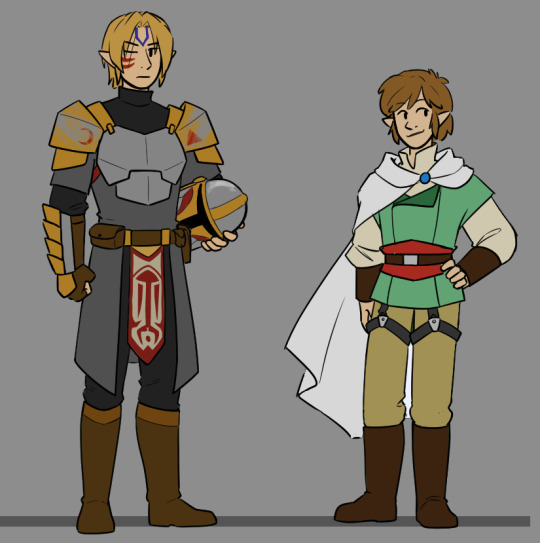
Time
Time is a direct survivor of Order 66. He was a child living in one of the more remote temples when everything happened, and was able to escape alive by fleeing into the dense forests of the planet.
Time spent many years after that traveling on his own and not getting close to anyone out of fear of being found out, or worse, left behind. He holds a certain bitterness towards everything that's happened, and when he was a teenager, he was involved in a major incident on the planet Termina. Time finally decided to bury his saber on a remote planet after that, unwilling to take on the responsibility that comes with it.
Time actually ended up meeting Sheik and donning Mandalorian armor some time after that in his teenage years. He doesnt always gel with Mandalorian warrior ideaology, but he doesn’t truly fit the Jedi way of his childhood anymore either, after all the war and death he’s seen. He's determined to be strong enough to protect those he cares about, like Malon.
Time doesn't entirely get along with the Chain at first. (Especially Warriors and Twilight; Warriors reminds him of his old Jedi master, who wore a red scarf, and Twilight's saber looks suspiciously familiar.) The boys eventually grew on him anyway, and he counts them among the people he cares about.
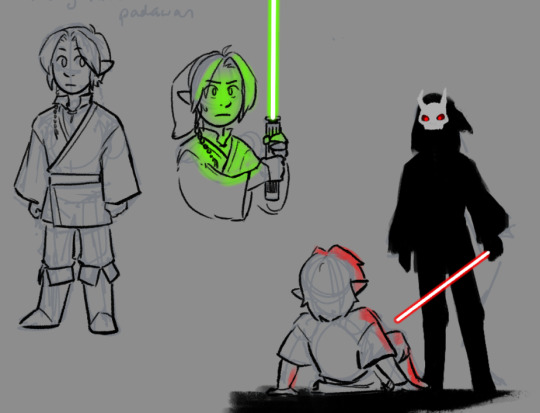
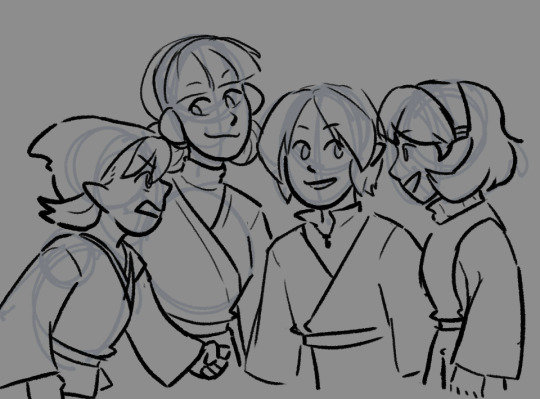
Sky
Sky comes from a gaseous planet in the Outer Rim with settlements that float in the clouds, constructed far above its surface.
Sky's planet is a bit of a cosmic mystery, since it should be impossible for islands of solid rock to float; some theorize that it was constructed instead of naturally occurring, or that there is a unique combination of magnetic fields and orbits that make it possible, but no one knows for certain. Loftwings are part of the planet's ecosystem of impossible floating islands, and are an important part of the culture there.
Being so remote, the Empire didn't show much interest in Sky's home planet until Ghirahim showed up. The Empire hasn’t taken over his home yet, and he is determined to keep it that way, along with the rest of the Knights of Skyloft (including Sun). Ghirahim's interest in the planet involved rumors that there was an old Jedi temple hidden on its surface, and the secrets that were hidden within it.
Those rumors turned out to be true; there was an ancient abandoned temple on one of the floating islands, and Sky and Sun ended up discovering it before Ghirahim did. Sky also found a protocol droid named F1, and with Fi's help he and Sun managed to forge their own sabers with the only remaining kyber crystals there.
Sky's connection to the Force manifests mostly as visions, and he occasionally experiences strange, cryptic dreams as a result.
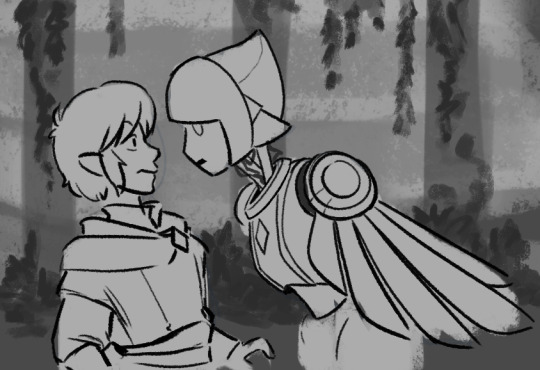
Linked Universe AU belongs to @ linkeduniverse!
#lu time#lu sky#lu star wars au#star wars au#linked universe#star wars#my art#mandalorian time my beloved#in case it isnt clear Saria and the forest kids were kids he grew up with at the temple#I left their fates ambiguous on purpose but point is he doesn’t really see them again after that#saria and the kokiri are FINE in my HEART#also I really like the worldbuilding for skyloft ooof#celestials and potenitally constructed systems exist in the lore and im abusing it to fit skyloft into star wars!!!!#god I wanna design sith ghirahim I think a saber battle between him and sky would be cool as hell to draw
581 notes
·
View notes
Text
Path to Nowhere: Cults, Cultures, and Cants project.
Cults, Cultures, and Cants is a fanfic worldbuilding project between me and some friends on the internet. It aims to deepen, expand, change, and add to the lore and setting of the Path to Nowhere gacha game, where the world is ending and hope gives way to mania, from the streets of DisCity to the white sands deep into BR-000 and beyond, as I, the creator, see fit.
Some things to expect of this project:
Cults: Sinners will have the ability to form "cults" by bonding with anyone of a certain mindset. Not unlike the chiefs Shackles. This system will strengthen the abilities "Patron" Sinner and grant new ones to themselves and their "Acolytes".
Cultures: This project will go deep into the nitty gritty of cultures, subcultures, and counter cultures that form within this setting, including their symbols, values, norms, and works.
Cants: Due to the effects of spiritually bonding with a patron, certain speech patterns within the cult will warp and change to the point of being unintelligible between members of one cult, another, and the mainstream cult that is DisCity. In reality, this is due to me, the creator, being a conlanger at heart and always looking for a chance to cram conlangs into any setting I get my hands on.
This is first and foremost a passion project. Anyone interested in this should not expect too much of it. However, I was never meant for the mainstream fandom anyways and love going my own way, so do expect to see some potentially risky (but still safe) head-canons to come into play. Other than that, I look forward to sharing this with you all and, hopefully, get some feedback and ideas from any and all of you who might be reading this.
< - > < - > < - > < - > < - > < - > < - > < - > < - > < - > < - > < - > < - > < - >
Editor's note: I changed the name of this project to Cults, Cultures, and Cants. This is purely for aesthetic purposes and that I love the alliteration.
I bolded the beginning of each explanation to separate the two and tie them to the title of this project.
I have also added some tags to better reach out to the community and have this circulate.
#path to nowhere#ptn cult culture#fanfiction#fan fiction#fanfic#fan project#ptnau#ptn au#path to nowhere alternate universe#worldbuilding#world building#alternate universe#fictional world#fictional culture#fictional cultures#culture building#fictional language#fictional languages#conlanging#language construction#language creation#glossopoeia#headworld#head world#paracosm
15 notes
·
View notes
Text

Krita sketch from 2021, part of a worldbuilding thing I keep tinkering with on and off again. This specific image (which I procrastinated on for a while) was intended to imitate a specific style of painting from some early time period, but I couldn't remember what it was for the life of me.
-In Universe Excerpt-
The name Tinovano T'hailuuno (literally ''Mountain's Melody", or "Mountain Songbird") is the given name attributed to a certain author in Vita-Ra ancient history.
She was likely native to the north of Kunee Harak'di (Eocene-epoch India), or at least educated in the city nations there. Most of her writing concerns documentation of the far northern continent (Eurasia) and the peoples that dwelled there, particular the illiterate yet metallurgically skilled "Moon-faced" predecessors of the Lunak'-Rha tribes. Copies of texts attributed to this author are likely some of the most well-preserved artifacts of the Pre-Modern millennia.
Whether or not Tinovano T'hailuuno was a single individual or multiple is something of scholarly debate (both names and careers tended to be passed down through a family lineage in this time and place). If a sole individual, the author was likely of brown plumage and possibly striped, as most Vita-Ra around the Tethys Ocean exhibited that phenotype at the time.
#vitara#vita-ra#conlang#constructed language#worldbuilding#original character#character concept#krita illustration#digital drawing#digital art#feathered dinosaurs#sapient#sentient#alternate history#alternate universe#fictional history#deviantart crosspost#scribe#explorer
31 notes
·
View notes
Text
Shadowhunters Universe Timeline
AKA how my stories align with canon books!
The main characters are the ones that have a pov in that book | the other characters are listed from the one that appears the most to the one that appears the least
Series: Life And Death
See The Heavens
Canon Timeline: The Mortal Instruments [Book 1-3]
Main Character(s): Elys Herondale
Other Characters: Lydia Shaw - Brian Lockwood - Alicent Shaw - Jackson Milligan - Pepper Orla - Morrigan Rowe - Dealindeh
Raise Hell
Canon Timeline: The Mortal Instruments [Book 4-6]
Main Character(s): Elys Herondale
Other Characters: Lydia Shaw - Brian Lockwood - Alicent Shaw - Jackson Milligan - Morrigan Rowe - Reign Proctor - Pepper Orla - Leah Harlan - Cassandra Blackthorn - Beleth - Jack Herondale
Champagne Problems
Canon Timeline: The Infernal Devices
Main Character(s): Selene Carstairs
Other Characters: Theodore Clarke - Alicent Shaw - Pepper Orla - Leah Harlan - Henrik Kade
Don't Fear The Fall
Canon Timeline: The Dark Artifices
Main Character(s): Cassandra Blackthorn
Other Characters: Elys Herondale - Jack Herondale - Henrik Kade - Camie Evans - Sagan - Marceline Seymour - Farrah Merryweather - Dealindeh - Nico Lightwood - Vice Verlac - Leah Harlan - Beleth
In The Middle Of The Darkest Night
Canon Timeline: The Last Hours
Main Character(s): Violet Lightwood; Samuel Milligan
Other Characters: Cressa Wayland - Selene Carstairs - Henrik Kade - Farrah Merryweather - Beleth - Alicent Shaw
Something Wicked
Canon Timeline: The Wicked Powers
Main Character(s): Cassandra Blackthorn; Nico Lightwood; Vice Verlac
Other Characters: Lenni Clarke + Others TBD (Since the series is not out yet)
Mystical Time
Canon Timeline: The Bane Chronicles + Other Non-Canonical Tales
Main Character(s): N/A
Other Characters: Alicent Shaw - Morrigan Rowe - Elys Herondale - Pepper Orla - Selene Carstairs - Theodore Clarke - Henrik Kade - Lydia Shaw
Deck The Halls (That We Once Walked Through)
Canon Timeline: Tales From The Shadowhunter Adademy + Other Non-Canonical Tales
Main Character(s): Vienna Lightwood
Other Characters: Elys Herondale - Jack Herondale - Violet Lightwood - Selene Carstairs - Samuel Milligan
Ghost Town
Canon Timeline: Ghosts Of The Shadow Market + Other Non-Canonical Tales
Main Character(s): N/A
Other Characters: Violet Lightwood - Selene Carstairs - Alicent Shaw - Camie Evans - Cressa Wayland - Pepper Orla - Leah Harlan - Elys Herondale - Jack Herondale - Cassandra Blackthorn
3 notes
·
View notes
Text
ok i wanna talk about the fae in my world because ive come up with a bunch of cool lore for them and their culture, im obviously not finished yet but this is what ive got so far
ok so in my little multiverse, the most common 2 groups to be present on each earth are fae and humans. on some earths the fae are less present in the story that occurs or on some they are very present. it all depends on the awareness fae and humans have of each other.
the 2 groups are very different and have very different cultures but they have many parallels between them
like each group has 3 main aspiration groups that overlap and have specific attributes whether physical or mental. humans have the sciences, the humanities, and the arts, while the fae have the storm, the end, and the spirit
there are 3 central figures to fae culture.
the storm also known as Ebbe who represents change, unpredictability, overcoming fears, flexibility. this figure is often depicted with dragonfly wings, which is often an attribute of their followers. They are also depicted in shadow with a hood over their head, normally with only one eye glinting out of the shadow of the hood, shining like lightning. after all the future is never truly clear, even to its beloved followers.
The next is the end, also known as lady death or Synneva. She represents death, as you might’ve guessed, but also familiarity, comfort, the solid earth to Ebbe’s ever-changing skies. She is often depicted with moth’s wings similar to the death’s head hawkmoth or just as a little moth lurking in a corner ever present. it is said that she watches over every death that has ever been, rocking them into her dusty embrace. when she is depicted, her face is never in shadow, because she is always known. she doesnt hurry or rush, she knows she will have you eventually and like you can’t run from your past, you cannot run from her.
and the last is the spirit, who is the one most likely to give you his name, which is Anders by the way. He’s the brightest of the bunch representing growth, revival, and life in general. while many fae claim they see Synneva during near death experiences and Ebbe during big make or break it decisions, people often say they see Anders during their greatest moments, often cheering in the background, jumping up and down. he appears when a person is truly living. hes often depicted with bee wings, pollinating and nurturing growth around him all with a big grin on his face. life flourishes around him. But hes a trickster as well, his tricks are short term rather than the big strange inscrutable crossroads Ebbe prefers. and hes always moving, because the present stops for no one.
these 3 are the main figures in fae culture, though there are many more that are present. often the followers or fae that share the most in common with a figure will take on their attributes. Unpredictable fae like Eden have dragonfly wings, while sunny ones have bee wings like Knaff, and calm ones like Kaia have moth’s. But there are those with birds wings, like Sage, who have Sparrow’s and there are some who have no wings. But often fae do have wings, that’s why “fae” is often interchangeable with “wingfolk.” its more common to see a fae with wings than without.
Also, fae view humans as having uncanny valley as well. they find the weird bare skin they have unsettling. also plastic is fucking weird like what the hell dude, why are you guys so obsessed with using it for everything. why do keep eating so much inedible shit like asbestos and lead as well?
#universe construction(worldbuilding)!#fae lore stuff#i spent like an hour writing this and it doesnt even encompass a lot of my feelings about the fae#i need to do art class hw ahhhh#and i have a math test tomorrow!!!#but here you go#its both for me and you to read and keep track of#just wanted to get some thoughts down#also yes Ebbe Synneva and Anders also represent Past Present and Future#i thought it would be fun#because of the myth of human children being replaced with changeling fae as a scapegoat to kill and abandon autistic kids i wanted to#flesh out the fae and give them a similar culture to humans so that it wouldnt have the oh no theyre so weird and unknowable that often#comes with fae and allistic people trying to ‘figure out’ autistics#its just a bigger way to say hey fuck off were not acceptable to kill just because we cant make eye contact or follow your dumb social rules#anyways rant over#hope you liked the block of text i typed out#if you see any typos#no you didnt
3 notes
·
View notes
Text
Talked about it a few times on my discord but I don't know how to translate it over to blog so I'll make this minipost lmao.
Because I like conlanging and also acknowledge that Great Connection or not that some individuals would've learned each other's tongues (but most bc I like conlangs) there are a few pidgins/creoles that exist in Sielsia.
Sky/Clan Pidgin
Skies drop noun classes, clans drop noun cases
Momentane and Iterative are removed
The moods are retained
only the mortal set pronuns are retained
Pack/Skulk Pidgins
Noun Classes = excl. animate vs. inanimate
Keep titles, honorifics are dropped
The number of titles shrink and simplify
These two pidgins are regularly referred to as Cat-Speak/Felitalk and Dogspeak/Canitalk respectively due to their focuses on each other. Now the Sky Kingdoms are the ones most likely to continue pressing for contact with the non-cats so;
Sky-Canine Pidgin
Noun Classes are kept - Ani vs. Semi vs. Inani
The paucal is lost
Iterative tense is aspect, traded for habitual
Momentane aspect is kept
Tenses are morphed to past, present, future
Animacy hierarchy markers are kept
The imperative mood stays
Only stand-alone pronouns
Titles are introduced and simplified
Articles and demonstratives are exempt from noun class
The Sky-Canine Pidgin is also known as Rogue-Speak as it's the tongue used most commonly by loners. It was a language born of necessity of the trade and I think I should actually call it a creole because it has native speakers now.
All of these are based on traits that each language shares so I think would make speaking easier/acceptable for them. For example, the kingdoms and clans both have independent vs. dependent categories for their pronouns so they keep them in their pidgin - meanwhile the canine languages only have independent forms so they'd drop the dependent forms in a pidgin.
The Packs and Skulks are far less isolationist than the clans are so while the clans and the kingdoms blossomed quite a few differences, the Skulks and Packs have similar enough grammar in their languages that very little has to change to create intelligibility once the parts are parsed.
2 notes
·
View notes
Text
I think I may have taken this advice a bit too far lmao
That which brightens your night and darkens your day is naught but the very singular corpse that beckons an omen more ancient and cruel than you could possibly comprehend.
I have a story that I've been working on for years and I have so many fun and horrifying ideas for it, this is kinda spoilers but it's so far down the line I doubt anyone will remember by the time I actually write it
The vast majority of the settings in this story take place on an Earth-like planet called Leusu. It has its own unique continents and landscape and cultures and especially languages but apart from that, most things are very similar to Earth. The biggest difference is that Leusu is in a binary orbit with another planet which has come to be known as Ausu. Ausu in its own right is very similar to Leusu. Similar size, also has life (although it's very different life), etc. And this causes some very cool astronomical effects. My favorite is the fact that there's a WHOLE ASS PLANET IN THE SKY that causes almost daily eclipses over most of Leusu. Like imagine if the moon were 100x bigger in the sky and caused a sunset at 2 in the afternoon and a few hours later caused a second sunrise. Just imagining the view gives me goosebumps
Of course there are tons of other effects (some of which being horrifying in and of themselves) but those aren't really relevant. What is is that this story's genre is a sort of sci-fi/modern fantasy blend (more atla fantasy than lotr fantasy). Some of the richest countries on Leusu have space programs that are only just now getting off the ground because of how difficult it is to figure out orbital mechanics when you're in such a chaotic gravitational environment as a binary system. But eventually, one of the countries launches a rocket (with one of the main cast on it) from Leusu to Ausu to observe the life there
What they find dumbfounds them. None of the rocks are dateable with any of the methods they try, and there's a disturbing lack of radioactive material in anything. The flora and fauna, while pretty normal looking for alien life on the outside, are incomprehensibly complex, as if they had evolved over the course of an uncountable number of years. Everything seems to react to their presence, even the grass and the soil. Oddly familiar fungal structures appear everywhere, one crew member thought they saw some enormous mycelium strands appear as pulsing veins in a cliffside. A mountain that the crew swore was to the north disappears and reappears in the south as if it had always been that way. Another one of them happens upon an immense frame structure made of steel that couldn't have been anything other than man-made. Which bewilders them even more since there has been zero evidence at all for there being any intelligent life on Ausu. Further inspection reveals a preserved catacomb filled with eldritch, withered markings in an unknown, long-dead alien language. Or at least that's what the characters in the story think.
The reader recognizes this language as English.
This story takes place hundreds of billions of years in the future.
Ausu is the long decayed but still living remnant of Earth.
And its old inhabitants are looking for it.
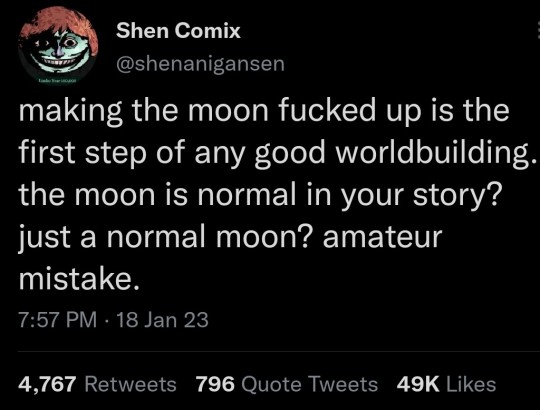
#also did I mention the entire planet itself is alive?#and is the single longest living organism in the entire universe?#and is sapient?#yeah...#world building#fantasy#worldbuilding#fantasy writing#creative writing#horror#cosmic horror#conlang#scifi#science fiction#science fantasy#horror writing#horror wip#speculative biology#special interest#xenobiology#constructed language#language#ire's lyre
57K notes
·
View notes
Text
In the past fifty years, fantasy’s greatest sin might be its creation of a bland, invariant, faux-Medieval European backdrop. The problem isn’t that every fantasy novel is set in the same place: pick a given book, and it probably deviates somehow. The problem is that the texture of this place gets everywhere.
What’s texture, specifically? Exactly what Elliot says: material culture. Social space. The textiles people use, the jobs they perform, the crops they harvest, the seasons they expect, even the way they construct their names. Fantasy writing doesn’t usually care much about these details, because it doesn’t usually care much about the little people – laborers, full-time mothers, sharecroppers, so on. (The last two books of Earthsea represent LeGuin’s remarkable attack on this tendency in her own writing.) So the fantasy writer defaults – fills in the tough details with the easiest available solution, and moves back to the world-saving, vengeance-seeking, intrigue-knotting narrative. Availability heuristics kick in, and we get another world of feudal serfs hunting deer and eating grains, of Western name constructions and Western social assumptions. (Husband and wife is not the universal historical norm for family structure, for instance.)
Defaulting is the root of a great many evils. Defaulting happens when we don’t think too much about something we write – a character description, a gender dynamic, a textile on display, the weave of the rug. Absent much thought, automaticity, the brain’s subsconscious autopilot, invokes the easiest available prototype – in the case of a gender dynamic, dad will read the paper, and mom will cut the protagonist’s hair. Or, in the case of worldbuilding, we default to the bland fantasy backdrop we know, and thereby reinforce it. It’s not done out of malice, but it’s still done.
The only way to fight this is by thinking about the little stuff. So: I was quite wrong. You do need to worldbuild pretty hard. Worldbuild against the grain, and worldbuild to challenge. Think about the little stuff. You don’t need to position every rain shadow and align every tectonic plate before you start your short story. But you do need to build a base of historical information that disrupts and overturns your implicit assumptions about how societies ‘ordinarily’ work, what they ‘ordinarily’ eat, who they ‘ordinarily’ sleep with. Remember that your slice of life experience is deeply atypical and selective, filtered through a particular culture with particular norms. If you stick to your easy automatic tendencies, you’ll produce sexist, racist writing – because our culture still has sexist, racist tendencies, tendencies we internalize, tendencies we can now even measure and quantify in a laboratory. And you’ll produce narrow writing, writing that generalizes a particular historical moment, its flavors and tongues, to a fantasy world that should be much broader and more varied. Don’t assume that the world you see around you, its structures and systems, is inevitable.
We... need worldbuilding by Seth Dickinson
#seth dickinson#worldbuilding#writing#ten.txt#if you're reading this go read the traitor baru cormorant#neowwww
9K notes
·
View notes
Text
i love the extras of dungeon meshi in how it fleshes out the world because they make it so much more evident how race affects every part of the story while avoiding the zootopia racism problem. like obv a main theme of the story is like, humanity and desire, 'to eat is to live', etc, but since the majority of it takes place in the dungeon isolated from society and thru the lens of laios, the racial aspects play out more like shadows on a wall for most of the story.
then in the extras we get comics like this

which at a glance fleshes out the racial aspects via a character explaining the racial rules of universe - humans have x amount of bones, while orcs and kobolds have more. however, if u take it less straightforwardly, it points out how the concept of 'human' is a constructed concept in the world. the fact that there are different categories of human in different parts of the world based off of what types of humanoids occur there is already a demonstration of this. in response, the bones explanation seems to kabru and the characters as an objective way of measuring humans vs nonhumans.
but obv, when the culture was deciding what humanoids were humans and nonhumans, they weren't blindly analyzing skeletons and then deciding. just visually, one can glean that orcs and kobolds look less like the ingroup of tallmen, elves, dwarves, gnomes, etc. the bones explanation appears as a justification for that immediate prejudice under a scientific guise - I'm sure that one could come up with the same number of physical differences between a gnome and an elf that they would find between a tallman and an orc. it sounds a lot better to say 'well, an orc has 230 bones while a human has 206' then 'well, an orc looks ewwww yucky yucky to me while a human looks normal'.
and what i like abt the comic is that the characters take the explanation at face value for the most part. when a contradiction is brought up in the oni, kabru can neatly slot them into the predetermined number of bones framework. bc that's kinda how it works irl - there r cultural prejudices that we can posthumously justify, and if we find something outside of it, we can twist it to fit into our predetermined binary. however, since the reader does not live in a world where there are orcs and kobolds to be prejudiced against, we can see that flaw in the cultural logic. when the party encounters the orcs, the number of bones has no bearing on their humanity. They r shown to be cliquish and distrusting of outsiders, but not any more than the elves are later in the story.
tldr dungeon meshi worldbuilding is so good
#just me#dungeon meshi#kabru#there r 10000000 examples of how fantasy racism affects the story of dungeon meshi not brought up in the main story#like namaris backstory and chilchucks union and the oni#augh. tasty manga#girls when themes of social isolation#ppl talk Abt the neurodivergent rep/allegory#the racial allegories aren't half bad either#social isolation guys social isolation
6K notes
·
View notes
Text
Okay, so a thing about Tolkien's Middle-Earth is that, for elves and other beings of comparable metaphysical stature, the "distance" between an act of will and its tangible result is shorter than it is for mortals. The universe is just more inclined to play along with how they want it to work, which is why they're not lying when they claim not to know what magic is even though the products of their craftsmanship are by any reasonable standard supernatural – they just make stuff, and it works the way it does because that's how they intended it to.
This has a number of fun worldbuilding implications, like inventors having tangible authority over things crafted using their techniques, regardless of who does the actual crafting, because they literally willed the principles which allow those techniques to work into being, or the fact that when powerful beings die, sometimes stuff that depends on techniques they invented stops working. However, there's a bigger implication that that's generally gone unaddressed:
Elves can't do science.
Like, it's straight up impossible. A Tolkien elf cannot construct and carry out a meaningful experiment of any sort – it'll always works the way they expect it to, but only for that particular elf. Confirmation bias is an insurmountable barrier.
I want to read a story about the elf who figures this out and it bothers them terribly.
#media#literature#lord of the rings#lotr#middle-earth#tolkien#j r r tolkien#elves#worldbuilding#science#death mention
8K notes
·
View notes
Note
a while ago you said that Starclan cats design kittens and customize them with patterns and colors from their parents genes. So, do the clan cats raise any eyebrows when it comes to people who know cat genetics? Is there a geneticist who is holding their head wondering how these two cats have this colored kit while their starclan designer was just playing around? Or do the Starclan designers still have to stay within the rules?
Basically, do the humans notice that some of these clan cats are sparkle cats lol
I try to not get too "lost in the weeds" since the humans aren't the focus of the story, just taking care that they DO have real motivations behind their actions rather than construction crews materializing out of nowhere to Do A Chaos, but...
First, the genetics of cats in Albion are different than humans in equivalent Great Britain.
Partially, this is because I honestly just don't really enjoy learning about in-depth genetics or applying them realistically. I like drawing anime characters and writing anime battles, so they have anime genetics. But more than that, off-screen, the intelligence of cats has altered the timeline of this world.
If cats really were capable of higher thinking, that totally would have had some butterfly effects. I like dropping crazy alt-history and then not elaborating on it, because it's funny. Archimedes' cat helped him invent a death ray, btw.
On that note of genetics though, you guessed right. StarClan designers DO have to work with what they have. Whatever the genetics of this alternate universe of cats are, every kit born still abides by the laws of nature.
Which brings me to...
Second, the researchers do notice that the Clan cats are special. In fact, there is a "study of magic" in this universe-- Thaumatology. "The science of wonder."
(There's no world where magic actually factually exists that science isn't all over it lmao)
Thaumatology facts I haven't shared so far since it's all offscreen and just Bonus Worldbuilding;
It is a "soft science," not a hard one.
It has a LOT of problems with replicability. Thaumatologists and Quantum Physicists have a lot of in-jokes.
The most well known (to the point of being a cliche) is "magic and quantum particles both hate being watched."
Magic is highly variable based on a bajillion very personal factors, like emotion, environment, culture, personal background, etc, so it's severely difficult to re-create it in controlled environments.
Thaumatology has a lot of overlap with sociology, archeology, and theology, so people from these fields work together a lot.
There was absolutely not a dedicated Thaumatologist working in the Research Team early on, sadly.
It was probably discovered when the Battle of the True Eclipse blew out a bunch of field cameras.
It's pretty common that photography equipment fritzes out a bit during "supernatural" times like eclipses, but the damage was extensive enough to be noteworty
The Clan cats were initially notable just for the fact they had advanced culture.
Cats are usually comparable to crows and monkeys, in this universe. So cats with fire and a crude writing system were enough to SHAKE the field of zoology.
The fact they're cats helped a lot. The public loves cats, enough that since their discovery after Speckletail attacked a bulldozer, massive outcry has secretly helped the Clans several times.
The discovery that the culture also has Thaumatological elements is more of a goldmine for a scientist than the public, though.
It's common knowledge that "animals are magic," because humanity projects traits onto them. "Of course they do, they're cats...?"
The Thaumatologist is freaking out because "THE CAT IS PROVABLY DOING ITS OWN THAUMATURGY"
Most people don't know the difference between Thaumaturgy (the functional work it does on the world) and Thaumology (the study of that as a whole), so this particular scientist is going to have a hard time explaining WHY this distinction is so special.
(And possibly even offensive to certain groups, who would insist only humans are capable of this)
In any case, eventually there would be Thaumatological interest in the Clan cats, but they weren't there in the mid to late 2010s when BB!ASC takes place.
#One of the things I like doing with The Researchers is making them relatable to my scientist friends lmaoo#So I like imagining the mundane reality of it all#There's exciting moments that make it all worth it-- but they have to grapple with budget a lot#Or their subjects breaking their equipment#Or an idea not working out the way they imagined it would#And trying to keep the public interested in their REALLY COOL PROJECT!!!#I was reading a paper on the swamp project in delamere and felt Incredibly Violent when i saw that they couldn't extensively re-wet one spo#Because there was a goddamn Go Ape Zipline#SCREW YOUR ZIPLINE OH MY GOD JUST MOVE IT#BITE BITE BITE BITE#''We could not remove the nearby patch of rhodo-motherfucking-dendron because a landowner thinks it's pretty :(''#1000000 US National Park Systems kill this man#Better Bones Au#Millie's Radio Collar
185 notes
·
View notes
Note
Your take on griffins is so cool 👀 Do you have worldbuilding notes somewhere? Like what their dynamic is with humans, or what their habitats and habits usually are? I’d love to know more about them!
Hey, thanks for asking! I actually had written a little species description for them, but I shelved it until I draw illustrations for it. However I might as well post it now with less relevant pictures. Who knows when would I get around to drawing those illustrations. First of all... there are no gryphons on Tetra. No mortal ones, just spirits.
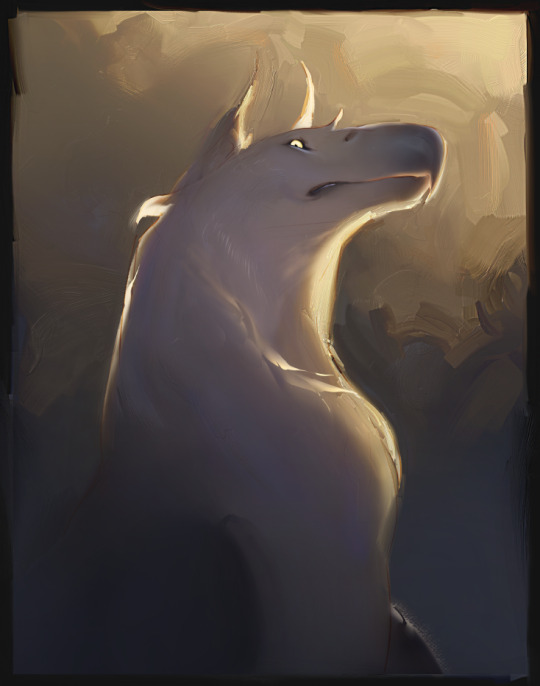
Spirits were created by the gods to be sentient blueprints for species. Flora & fauna were created out of chosen spirits (e.g. polar bear, barn owl), and the leftovers were repurposed (e.g. great horned gryphon, common pegasus).
In addition to the whole range of shapes/forms spirits were designed to take as part of nature, they also had their would-be behavioral patterns pre-set into them. So now lets see how the Great Horned Gryphons would have lived!
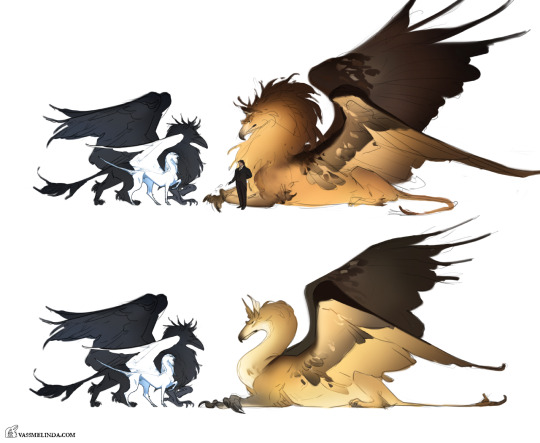
Great horned gryphons (also simply referred to as 'griffins' from now on) are sexually dimorphic, and live in pairs. They are very resource-conscious - individuals not raised properly may hunt their food sources to extinction, after which they either starve to death or get themselves killed while ravaging the animals of other griffins or humans. Each pair oversees a vast territory filled with wild herd animals. They engage in several behaviors that are basically animal husbandry. They will protect their herds from other predators and even natural disasters. They will herd their animals toward quality food. They can recognize juveniles of many species - humans included -, and will not eat them. They sometimes raise the abandoned offspring of other species, not because they plan to eat them, but because they get a kick out of it. They don't hunt, per se. They hit up one of their herds, select a specimen, and carry it home for lunch. They like to construct their nests atop cliffs and similar high points overlooking their territory.
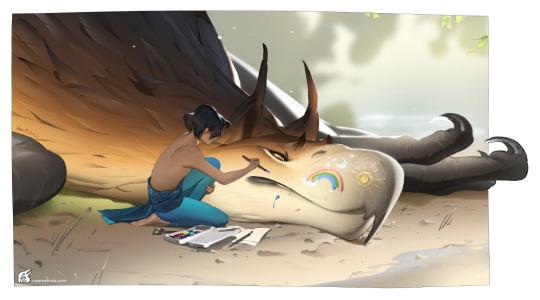
Their relationship with people is complex (and hypothetical, as is everything else), since people may want to claim the same lands for the same purposes. But typically if they saw a lone human child, just waltzing around on their territory, they'd pick it up and put it down near adult humans. Solitary adult people tend to be safe as well for different reasons. The staple of griffins is large animals, and they like to conserve their energy. Normally they won't get up for 1 lone human nugget.

If an adult pair spots an unrelated juvenile griffin on their turf, they leave it alone, but they don't tolerate mature trespassers or other pairs. They are hostile to all other species of gryphon. Given the opportunity, they will kill and eat them. Great horned gryphons are viviparous and give birth to 1 chick at a time which stays with the parents for several years to learn some manners. Mostly moderation, recognizing important animal species, and caring for their animals. Their lifespan is 40-70 years.
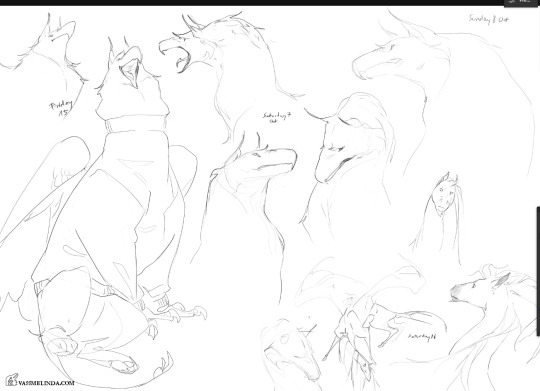
And that's more or less it. At present, great horned gryphons are not plural. There's just one spirit, Griffin, representing the whole species, either until the heat death of the universe or until he bites the dust. Spirits are shapeshifters with a range of native forms as opposed to one original form. They have some rules among them on etiquette, such as when is it ok to take the form of another spirit. Griffin mostly uses his adult male form, and lets Phoenix take his adult female one.
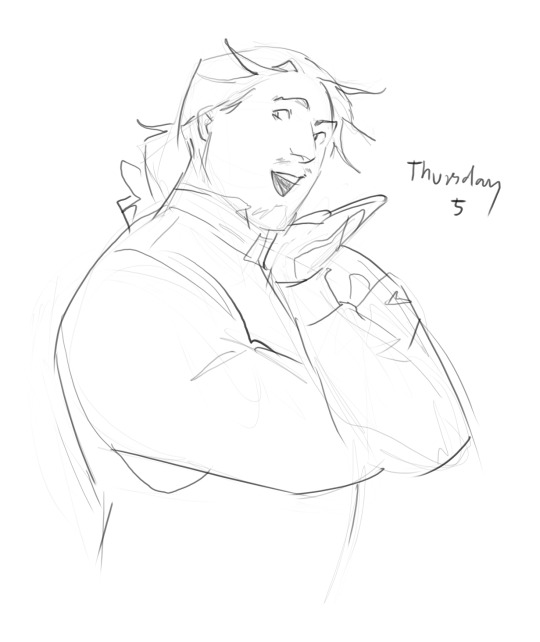
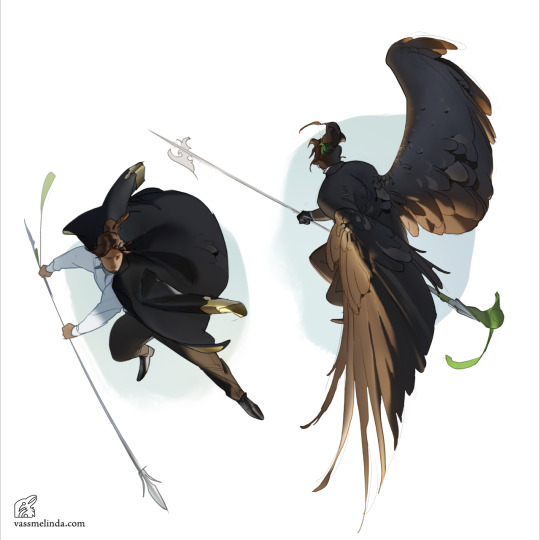
Several of his species' characteristics can be felt in his personality - excels at relaxing, hard to anger or scare, won't hurt kids or pets and is good with them, extraverted, resource-conscious, enjoys having vast lands. His relationship with humans is... complicated. Nowadays he kinda pretends to be a pet at the palace of the emperor of the Karkian Empire, and is banned from or unwelcome in several other countries. Sorcerers summon him sometimes, but the jolly fucker usually charges by the hour for his spirit-y services, and may even screw the summoners over if he doesn't like them.
315 notes
·
View notes
Text
Cryptonian Conlangs: Help wanted.
I need to make a few languages, they aren't supposed to be natural, for a confederation of supernatural hackers, one faction of which can upload their own bodies as well as those they take with them into a digital world, Tron style. I want these languages to feel like programming languages and I have a few ideas on how to achieve that:
Labeling of parts of speech to clear up ambiguity.
Variable assignment as anaphora.
vocal bracketing to set apart different parts of a sentence and enclose quotes.
Every sentence starting with a line identifier that can be used as a sort of anaphora when referencing them shorthanded.
What else could I do to achieve this effect? Also, I might also look to esoteric programming languages for inspiration as well.
#mvtjournalist speaks#mvtjournalist asks#path to nowhere#path to nowhere au#path to nowhere alternate universe#ptn au#ptn alternat universe#conlanging#language construction#language creation#glossopoeia#conlangs#conlang#constructed languages#artistic languages#artlangs#personal languages#personal language#fanlangs#fanlang#fandom languages#fandom language#fan fiction#fanfiction#worldbuilding#world building#fictional culture#conculture#headworld#paracosm
5 notes
·
View notes
Text
Some Worldbuilding Vocabulary

Abeyance: When the audience temporarily suspends their questions about made-up words or worldbuilding details with the implicit understanding that they will be answered later in the story.
Absorption: The two-way street wherein the audience is immersed in the created world and is picking up the author’s metaphoric building blocks to recreate the concept in their head.
Acculturation: When an adult assimilates into another culture.
Additive: When something has been added to a secondary world, usually in the form of magic or fantasy species.
Affinity: A kinship pattern wherein the familial bond is based upon marriage.
Aggregate Inconsistencies: When audiences pick up internal inconsistencies not within the same story but from multiple sources within the shared universe.
Anachronism: Details that do not conform to their time period or culture.
Analogue Culture: Real-life cultures that the creator emulates in their work and then applies their fantasy conceits to.
Ancestor Worship: The belief that deceased ancestors still exist, are still a part of the family, and can intervene within the living world on their descendants’ behalf.
Animism: The belief that all objects, creatures, and places are imbued with a spiritual essence.
Apex Predator: The predator at the top of a food web that no other creature naturally feeds upon. Two apex predators cannot exist in the same niche.
Apologetics: In worldbuilding, the attempt to explain inconsistencies in terms of existing canon.
Appropriated Culture: Using a culture as a whole that the creator is not a member of. Different from an analogue culture in that the analogue is changed by the creator and used respectfully.
Artifacts: In worldbuilding, the observable ways a culture behaves due to their cultural worldview. This can include politics, economics, religion, education, arts, humanities, and linguistics, along with many other cultural norms.
Ascendant: In worldbuilding, a world that the magic is increasing in power and influence.
Assimilation: When an individual rejects their original culture and adopts the cultural norms and beliefs of the dominant culture.
Author Authority: When an author demonstrates expert-level knowledge in a field to their audience.
Author Worldview: What Mark J. P. Wolf calls “not only the ideas and ideologies of the world’s inhabitants, but also those which the author is expressing through the world’s structure of events.”
Autocracy: A government in which supreme power concentrates in the hands of one individual or polity.
Avatar: The embodiment of a deity in another form, usually humanoid.
B-C
Bible: In the field of television writing, a series guidebook that usually includes the pitch, character descriptions, a synopsis, as well as worldbuilding details.
Biome: The vegetation and animals that exists within a region. Terrestrial biomes include: forest (tropical, temperate, or boreal), grassland, desert, and tundra.
Black Box: In information processing, when a system is viewed in terms of its inputs and outputs without any understanding as to its internal workings.
Bottom-Up: In design, where the granular, base elements of the system are created first, then grouping them together into larger constructs over and over until a pattern forms. Also known as “pantsing” in writing and worldbuilding because the creator is building by the seat of their pants.
Callback: From standup comedy where the punchline in a joke used earlier in the set is alluded to again, eliciting another laugh from the reframing of what was already familiar.
Canon: The core doctrine for the world when conflicting information arises. Usually what the original creator made takes canonical precedence over subsequent additions.
Capitalism: The economic system wherein individuals own the means of production.
Chekhov's Gun: Often understood to mean that something must be introduced previously if it will have significance later in a narrative, but meant by the playwright that nothing should be included in the story that is not completely necessary.
Climate: The temperature and rainfall in regions over approximately 30 years. Classified as tropical (high temperature and high precipitation), dry (high temperature and low precipitation), temperate (mid temperature and mid precipitation), continental (in the center of large continents with warm summers and cold winters), and polar (low temperatures and low precipitation).
Commercial Fiction: The style of fiction that includes all genre fiction, the aim of which is entertainment. Often fast-paced and plot-driven.
Compelling: One of the four Cs of worldbuilding, which deals with how well the core concept and subsequent details maintain audience interest.
Complete: One of the four Cs of worldbuilding, which deals with the sense that the world is lived in, has a sense of history, and continues on even when the story ends.
Complexity Creep: When material gradually grows in complexity over its lifetime, raising the bar of entry for new people experiencing the material for the first time.
Conceits: Where a story deviates from reality. Usually the focus of the fiction by being what the author intends on exploring in their works.
Conlanguage: A constructed language created specifically for a story world.
Consanguinity: A kinship pattern wherein the familial bond is based upon a shared genetic lineage.
Consistent: One of the four Cs of worldbuilding, which deals with how well the material maintains its own internal logic as established by the fantasy conceits.
Constructed World: A fictional world that does not exist but was created by someone.
Continuity: A gestalt term for perception where the mind fills in obvious blanks to make a unified whole.
Convergent Evolution: When two or more species develop analogous features to deal with their environment.
Co-Residency: A kinship pattern wherein the familial bond is based upon shared space.
Cosmology: The study of mapping the universe and our place in it.
Cost: In worldbuilding, when a character must risk or sacrifice something for magic to take effect.
Creative: One of the four Cs of worldbuilding, which deals with how and to what extent the constructed world deviates from the real world.
Credibility Threshold: Where worldbuilding details must only appear plausible to a general audience rather than demonstrating expert-level knowledge.
Cultural Identity: An individual’s self-concept as distinct from others based upon nationality, ethnicity, social class, generation, and locality.
Cultural Universals: Traits, patterns, and institutions prevalent throughout humankind.
Customs: Informal rules of behavior that people take part in without thinking about it.
D-F
Deity: The most powerful of metaphysical entities, deities often exist in pantheons, have thematic powers based upon their roles, and few weaknesses or limitations.
Descendent: In terms of magic, the idea that the most powerful magics are from ages past and that magic is on the decline in terms of power and influence.
Despotism: An economic system wherein an individual or institution controls the laws and resources of an area.
Deus Ex Machina: A plot device in which an unexpected power, event, or deity intervenes to save a hopeless situation.
Differentiation: When one culture forms part of their identity by contrasting themselves with another nearby culture.
Divergent: When the creator alters something in the development of the world but it remains very similar to the real world in every detail but this fantasy conceit. For instance, a world that resembles our own but made up of anthropomorphic animals instead of humans.
Divine: The belief that something is of, from, or like a god.
Democracy: A government in which the people elect a governing body in some fashion.
Early Adoption: When an inventor or culture creates a technology long before their analogue culture did in the real world.
Easter Egg: A hidden message, image, or feature that is meant to be hunted for within the material.
Economics: The study of production, distribution, and consumption of goods and services.
Education: A form of socialization in which we teach the youth what they need to know to become functioning members of society.
Effective Worldbuilding: When (a) the immersive state is never disrupted for the audience, or when (b) the immersive state is disrupted with a positive result.
Element X: N. K. Jemisin’s concept of when fantasy elements diverge from the real world. Similar to fantasy conceits.
Emic: An account of a cultural idea, concept, behavior, or belief documented as if from within the culture.
Empires: Multinational states with political hegemony over other ethnicities, cultures, or nations.
Encyclopedic Impulse: The consumer’s desire to know everything about the world or the author’s desire to expound upon all the worldbuilding details.
Ephemera: Transitionary materials that are not meant to exist for long term, such as advertisements, diary entries, letters, posters, and the like.
Ethnicity: A group that identifies with each other based on presumed similarities such as a shared language, ancestry, history, society, or social treatment within an area. Ethnicities are not dependent upon, but are often associated with, certain taxonomic traits or physiological similarities within those groups.
Etic: When cultural ideas, concepts, behaviors, or beliefs are documented from outside the cultural milieu as a passive observer with an eye for similarities between all cultures
Exsecting: When the creator removes something that exists in the real world from the created world.
Extrapolation: In worldbuilding, the belief that any fantasy conceit should be followed to its natural conclusion.
Face Validity: When worldbuilding detail appears believable upon immediate examination. See Credibility Threshold.
Fan Service: Material included in a story that serves no narrative purpose other than to please fans.
Fantasy Conceit: What the creator intends to explore in the world, it is where the constructed world deviates from the real world, usually in the form of geography, biology, physics, metaphysics, technology, or culture.
Fantasy Function: When analogue cultures are filtered through fantasy conceits to populate the created world with its output details.
Fetishes: Items imbued with cultural significance and power.
First Principles: Core belief and value systems within a culture that are often unconscious until confronted.
Flavor Text: Texts within stories, video games, role-playing games, and action figures that add depth by providing a sense of history but do not alter the game mechanics or story in a substantial way.
Feudalism: An economic system wherein there is a division between the lords that protect the vassals that work the land in exchange for protection.
Four Cs of Worldbuilding: See Creative, Complete, Consistent, and Compelling.
G-L
Gender: A social construct of how cultures differentiate the sexes.
Generalist: When every individual in a society has the same basic job, which is providing their daily caloric intake. A staple of hunter and gatherers and in contrast to specialists.
Generation: A social cohort group based around the period in which children grow up, become adults, and bear children of their own. Because of this shared timeframe and significant events in their lives, generations often share a similar worldview within the general culture.
Genre Expectation: The qualities audiences expect of their genres to be considered successful, i.e. is the thriller thrilling or the romance romantic. For fantasy and science fiction, the genre expectation is worldbuilding.
Goldilocks Zone: The habitable zone around a star where the temperature is right for water to exist in liquid form.
Group: Two or more individuals who share a collective sense of unity via interacting with each other because of shared similar characteristics.
Habitat: The ecosystem or ecological community creatures exist in.
Handwave: A writing term for explaining crucial events dismissively with minimal details.
Handwavium: As opposed to the handwave, when everything else in the imagined world fits logically together with the exception of the fantasy conceit, which the audience must then accept to continue on with the story.
Hard Deduction: When there is no narrator and no character bringing the worldbuilding details to the audience’s attention, who must then piece together the world rules based upon the provided details alone.
Hard Impart: When information is imparted to the audience through narrative text, usually through the narrator or the internal thoughts of characters.
Hero Props: Items that are necessary for a scene to take place, making them integral to the story.
Heroic Theory of Invention: When inventors and discoverers of scientific developments are treated as solitary geniuses rather than products of good luck or a part of a team.
High-Concept: A term from the film industry meaning an idea needs lots of background details, usually compiled from the worldbuilding, to be explained for the core concept to be compelling.
Hybrid: (a) In biology, a living thing bred together from two different species, which is not able to produce its own viable offspring. (b) A method the author can employ to get details across to the audience in which it appears they are using a hard or soft impart, but the audience deduces are not correct, which then casts provided information into doubt and adds new nuance.
Iceberg Theory: The theory proffered by Hemingway that so long as the author is aware of the underlying ideas, they can cut away anything from the story and it will still make sense. Usually interpreted to mean one only needs to reveal 10% of worldbuilding details or backstory.
Illusion of Completeness: The sense that the world is complete and that all questions can be answered within it rather than the creator explicitly spelling out all the details.
Immersion: The altered state in which the audience feels they are physically present in a non-physical world.
Ineffective Worldbuilding: When worldbuilding details become obvious to the consumer, thus breaking the sense of immersion and reminding them of the real world. This can be caused by internal inconsistencies or from reality incursions.
Info Dump: A sudden overwhelming quantity of backstory or background information supplied in a short timeframe.
Info Dump Equity: The idea that an author should not reveal worldbuilding information until the audience craves it, thus being able to deliver an info dump without anyone complaining.
In-Group: The other people an individual identifies with. While they may not share the exact worldview, they share the same first principles in understanding the world around them.
Innovation: The drive for change, usually technological, but also socially.
Inside-Out: How audiences process worldbuilding details, in that they pertain to the immediate understanding of the scene, which are then pieced together into an understanding of the world.
Inspired Worldbuilding: The top form of worldbuilding, which invites additional audience interaction via their imagination after the story has concluded.
Institutions: Stable organizations of individuals formed for a shared purpose, usually by performing specific, reoccurring patterns of behavior.
Integration: When an individual adopts the cultural norms and beliefs of the dominant culture while still retaining their original culture.
Interconnection: When the threads of worldbuilding are tied together cohesively. Part of Sanderson’s third law of magic systems.
Interquel: Stories set in an existing world but that do not connect with the original story.
Intraquel: Stories set in an existing world that fill in gaps in the existing story.
Kinship: How social relationships organize into groups, roles, and families. Usually consisting of consanguinity, affinity, or co-residency.
Limitations: Checks put upon magical powers, usually in the form of weaknesses and costs. Sanderson maintains in his second law that limitations are more dramatically important than powers.
Linguistics: The study of languages.
Literary Fiction: The style of fiction that aims for awards, considers itself art, focuses on the prose, and is usually slowly paced.
Locality: The small-scale community in which the individuals in a group grew up, usually comprising of a town, neighborhood, or block, which differentiates them from others in the surrounding area.
M-O
Macroworldbuilding: The first of the stages N. K. Jemisin breaks her worldbuilding process into, which consists of planet, continents, climate, and ecology.
Magic: Change wrought through unnatural means.
Magic Point Systems: Magic systems where the casters have a set amount of energy, usually referred to as mana, to spend on their effects.
Magical Thinking: The belief people can affect change the world around them through thoughts and behaviors.
Mana: A frequent generalized term for the finite resource magic users spend on their magical effects.
Marginalization: When an individual rejects both their original culture and the dominant culture.
Mary Sue/ Marty Sue: Originally a created character for fanfic who has no flaws and is inserted into interactions with the canonical characters. Now an insult leveled at characters consumers don’t like, usually claiming they are overly capable and without flaws.
Masquerade: A term taking from the World of Darkness RPG wherein the existence of magic is hidden from the general populous.
Metaphysics: In worldbuilding, dealing with deities, spirits, cosmology, and the afterlife. In essence, creatures and locations that do not abide by understandings of biology or physics.
Microworldbuilding: The second of the stages N. K. Jemisin breaks her worldbuilding process into, which consists of species, morphology, raciation, acculturation, power, and role.
Monotheism: The belief in a single deity only.
Mystery Box: The theory proffered by JJ Abrams that mystery drives audience interest, which will keep them invested in a story so long as they are promised elucidation later.
Mythopeia: Constructed mythologies, lores, and histories within created worlds.
Nationality: How an individual relates to their state. A component of cultural identity.
Nominal Change: A superficial change in the secondary world that contributes nothing to the worldbuilding.
Norms: What is considered acceptable group behavior and what people should and should not do in their social surroundings.
Oligarchy: A government in which power rests in a small group of people like the nobility, wealthy, or religious leaders.
One-Off: An intentional inconsistency meant to highlight the aberration as separate from the established worldbuilding.
Out-Group: Those that do not share the same collective worldview, which are often mistrusted or viewed with outright hostility.
Overlaid Worlds: Constructed worlds with real-world locations but with the addition of fantasy elements.
P-R
Pantheon: A categorization of collected deities based upon the culture that worships them
Pantsers: Creators who build or write without a clear outcome in mind. See Bottom-Up.
Pidgin Language: A grammatically simplified language used for trade that comprises vocabularies drawn from numerous languages.
Planet of Hats: The trope of treating a species or world as monolithic and with one defining trait.
Planners: Worldbuilders or writers who have a clear plan once they start creating. See Top-Down.
Politics: The decision-making process within groups and individuals involving power structures.
Polytheism: The belief of multiple gods, usually inhabiting a pantheon.
Porcelain Argument: In worldbuilding, the belief that technology stagnates at the level at which magic or a fantasy conceit is introduced.
Portal Fantasy: A subgenre in which the characters from the real world travel to a secondary world.
Prequel: Stories set in an existing world that precede the original story. They do not need to connect to the original story but often do.
Primary Sexual Characteristics: The sex organs used in reproduction.
Primary World: The real world in which we all reside and draw our experience from.
Prime Mover: A conceit that cannot be removed without the story world falling apart.
Profane: Something that is religiously blasphemous or obscene.
Prologue: An opening sequence in a narrative that establishes background details to create context, clarification, and miscellaneous information for the audience
Promise of the Premise: The term coined by Blake Snyder for the point in the story when the setup is complete and it examines its core conceits. An author breaks the promise of the premise when the story is not about the promised core concepts.
Pull Factors: Factors that draw immigrants to an area.
Purple Prose: Descriptions that becomes overly ornate and extravagant, to the point they break the sense of immersion by drawing attention to themselves.
Push Factors: Factors that drive immigrants out of an area.
Race: (a) In biology, a grouping of populations below the level of subspecies, and is rather imprecise in distinguishing the differences between them. (b) In the fantasy genre, usually understood to mean “species.”
Racial Attributes: The assumption that any one fantasy race shares not only certain abilities like flight or the capacity to speak with animals, but certain demeanors, temperaments, and biases.
Reality Incursions: When the outside world interjects itself into the created fantasy experience to remind the consumer that this is indeed a made-up world. They usually occur when the consumer has expert knowledge in a field that is not depicted correctly in the narrative.
Reciprocity: When people respond to actions with similar actions. This can be positive, as in the exchanging of gifts, or negative, as with punitive eye-for-an-eye punishments for crimes.
Relativism: The belief there is no real objective universal truth and that we base all understanding upon perception and consideration.
Religion: The cultural system of behaviors, morals, ethics, and worldview in which humans deal with supernatural, metaphysical, and spiritual conceptions.
Retcon: Short for “retroactive continuity,” the term comes from comic books when previous canon or facts are ignored or contradicted so as to assimilate new stories or understandings in current storylines.
Reverberations and Repercussions: The understanding that any change within a world creates many expected and unexpected changes to the whole.
Rituals: Formal customs often involving gestures, words, and objects performed in a traditional sequence.
Rule of Cool: The understanding that the audience’s willing suspension of disbelief for a given element is directly proportional to its level of “coolness.”
Rule of Law: The idea that laws extend to the lawmakers as well as the general populous.
Rule of Three: In worldbuilding, the concept coined by Randy Ellefson in which an author should alter at least three components of a trope to make it their own.
S
Saturation: Mark J. P. Wolf’s term for when there are simply too many details for the audience to fully absorb, which he maintains makes the world stronger since it invites the audience to reexperience the material again and again to glean something new each time.
Scarcity: When people put higher value on rare things and assign lesser value to things in abundance.
Secondary Sexual Characteristics: The distinguishing traits that distinguish the sexes, such as human males’ facial hair or females’ breasts.
Secondary World: A created world that does not exist.
Selection: In biology, the preferential survival and reproduction or elimination of individuals with certain traits. Can be either artificial, natural, positive, or negative.
Separation: When an individual rejects the dominant culture in favor of preserving their original culture, which often leads to minority enclaves within the dominant culture
Sequel: Stories set in an existing world that follow the original story. They do not need to connect to the original story but often do.
Set Piece: An iconic scene that exemplifies the story even though it might not actually be necessary to the story itself.
Shamanism: The belief that specific individuals have access to and influence over the spiritual realm, usually derived by ritual and entering altered states.
Show Don't Tell: The understanding that the audience prefers to experience the worldbuilding details and storytelling events in action rather than having them explained.
Smeerp: Unnecessarily renaming something to make it seem exotic. Derived from James Blish’s sarcastic use of the term when describing rabbits.
Smeerp Hole: When one seemingly minor change contributes to a whole slew of other changes on the author’s part that add little to the audience experience as a whole.
Social Class: The hierarchal social stratification of groups, usually manifesting as upper, middle, and lower classes.
Socialism: The economic system in which the workers or government own and manage the means of production.
Socialization: The process in which a group passes on the worldviews, norms, and customs to their children.
Soft Deduction: When a character with knowledge of the worldbuilding takes action based upon specific information to get the worldbuilding rules across to the audience.
Soft Impart: Information presented to the audience not through narrative text but through a trustworthy side character or source. Can often come about from an overheard conversation or explanation from another character.
Specialization: The divisions of labor and creation of occupations when the population does not individually have to account for their daily caloric intake. As opposed to generalist.
Species: A group of living creatures capable of exchanging genetic material and producing viable offspring.
Speculative Fiction: An umbrella term for fiction that inject elements into the story that do not exist in the real world. Fantasy, science fiction, horror, historical fiction, alternative history, and dystopian and utopian fiction are just a few genres that qualify as speculative fiction.
Spotlighted/Lampshaded: A potentially troublesome concept or idea that is intentionally brought to the audience’s attention before it becomes problematic to highlight that it is intended as a fantasy conceit rather than an accidental anachronism.
Stasis: The drive to maintain the current order, be it social, political, or technological.
States: Organized governments overseeing a specific territory that can interact with other states.
Streamlining: Part of Sanderson’s third law of magic in which worldbuilding details should be accounted for by already existing fantasy conceits instead of creating whole new conceits.
Suspension of Disbelief: When an audience makes a choice to suspend their critical faculties to allow for a patently unreal concept to be considered logical for the sake of entertainment.
T-W
Taming: When an animal has been taught to tolerate human presence. As opposed to domestication.
Technobabble: When a character spouts a number of details to establish their expert credentials in the field. Technobabble is not meant to be understood by either the audience or the other characters, only to establish the character’s authority on the subject.
Terra De Facto: The implicit understanding that anything that is not accounted for by a fantasy conceit must therefore abide by the rules of the primary world.
Terrain: The vertical and horizontal proportions of land masses, which includes how high it is above sea level and at what slope.
Theocracy: A government where the religious leaders and practices control the laws in addition to the religious norms and rituals.
Toehold Details: Descriptors that specifically trigger the assumption of an analogue culture and time period, and therefore help the audience to mentally populate the scene.
Top-Down: In design, when the underlying idea or system is formed on a grand scale, then with all subsequent subsystems being added and refined until everything is mapped out. Also referred to as “planner” or “engineer” when it comes to writing or worldbuilding.
Totems: Imbued emblems representing a group of people tied to a specific spirit.
Transmedial: When a story or world exists in multiple mediums.
Tropes: Reoccurring motifs, images, plots, and characterization that exist within a genre.
Unchanged: When the creator does not use a particular fantasy conceit and leaves their created world the same as the real world in regards to this fantasy conceit. See Terra De Facto.
Unobtanium: In engineering, the term used for materials or technologies that do not yet exist but will one day solve current problems. Frequently used in science fiction worldbuilding.
Upmarket Fiction: The style of fiction that aims for creating discussion. It often blends literary and commercial fiction, deals with universal themes, has accessible language, and is character-driven.
Weakness: Limiting factors that diminish the power or the person using it. Part of Sanderson’s second law of magic.
Worldbuilding Capital: Time and mental energy sunk into a world, which is why authors frequently reuse the existing world instead of forming a new one for subsequent stories.
Worldbuilding Kudzu: When too many worldbuilding choke out the pertinent information by sheer volume, thus disrupting immersion.
Worldview: How a society or individual orients their knowledge and point of view towards the world. This includes philosophy, fundamentals, existential postulates, values and ethics, ideology, and attitude. It encompasses the concept of why the world works the way it does and the “correct” way to act within it.
Worship: The act of religious devotion towards a deity or ideal.
Source ⚜ More: Word Lists
#worldbuilding#terminology#writeblr#fantasy#dark academia#writers on tumblr#writing reference#spilled ink#literature#poets on tumblr#writing prompt#poetry#fiction#novel#creative writing#light academia#lit#words#langblr#linguistics#booklr#bookblr#rene magritte#writing resources
159 notes
·
View notes
Text
the current phonology is pretty solid, it makes me think of Mark Rosenfelder's unreleased conlang for one of his species in his big worldbuilding project. A feature of that conlang is that it is purely tonal and could be hummed, sung, or written.
Phonetics and semi-related features aside, I am curious about the grammar of this conlang. There is so much potential for such an alien species to be reflected in their language.
Some suggestions:
The Gems could have two words for "body" in their lexicon (basically a dictionary) in which one is the individual's gem and the other is the projected body that said Gem can shapeshift.
What could resemble verbs in this language might not be marked for tense since Gems are effectively immortal and might therefore have a more relaxed view on time. Instead verbs can be marked for how the action happens (aspect), how the speaker feels about said action (mood), and some other conjugations.
Gems might have a formal way of talking in the presence of diamonds, rather than the more casual way they refer to each other.
That's all I got for suggestions at the moment. It is really nice to see more fanlangs being shared on the internet. I wish you luck in your endeavor.
Gemglyph
So, on top of redesigning and everything, I am also redesigning gem language. It always came off as kind of weird that Gems were just... fluent in English. Only reasonable explanation I could think of is Gems introducing English to humans in the show. I disagree. Let's add a language barrier.
So, Gems in my AU produce sounds through their gem. They produce low humming, and more high-pitch rings and dings. This composes the basics of their spoken language. They also have a written form, although it's a lot more uncommon, and often written in sacred locations, to announce names, locations, place wards, etc. Gem religious ideas is something I also will maybe get into.

They also commonly utilize technology, although technology is interfaced directly through the mind (since their gem is technology), so there is no visual component beyond the ergonomic designs marking it as a usable computer. This was partially inspired by when Pearl piloted the Gem Warship.

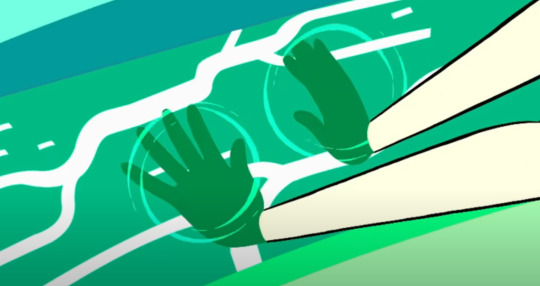

Moving on, here's some of the iterations for Gemglyph I've had. The primary idea is that it moves along a fixed line, similar to music. The fixed line changes depending on the background humming, and notes are marked across it. A sentence ending would be marked by a harsh line cutting across the central line. This could allow sentences to be written in multiple artistic ways, such as spiraling, squiggles, you name it. Also, I just like the look.


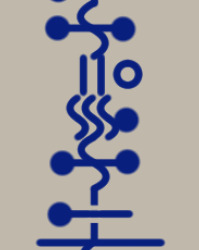
After a lot of listening to sounds, since I wanted to make sure the noises I was selecting weren't nonexistent or impossible to hear the difference from. After that little experiment, the alphabet changed again. There were also suggestions to change how notes and lines look, to make it less muddled and confusing.

The language is presently heavy in workshop, and could probably use more notes to add more letter variety. For now, however, this is where it is. Suggestions endlessly appreciated, I've never made a conlang before. I'm also creating a list of base words, and trying to figure grammar. It's great.
#conlanging#language construction#language creation#glossopoeia#conlang#constructed language#fictional language#Fanlang#steven universe#steven universe au#su au#fanfiction#worldbuilding
14 notes
·
View notes
Note
AEIWAM: Which character(s) did you change the most, and which did you change the least?
Hmm. It's hard to say is the "most" different from their canon incarnation, because once a small change is made, they're forever different, but in terms of HOW they've been changed:
1: Smash The Vase Of Canon And Make A Mosaic From The Pieces I took the stated background of the character, worked out what Priorities/Motivations/Skills a character with that background would actually HAVE, then approached the remaining canon events with those motivations, which seems to result in a character totally different from, yet still recognizable as, the original Tousen, Unohana, Komamura, Yamamoto, Byakuya, Ulquiorra, Jugram, Gerard Valkyrie, Ichibei Hyosube, Oetsu Nimiya, Kirio Hikifune, Kon, Giselle Gwelle
2: Yeah They've Always Been Like That This character's background is a fuckin' VOID (or extremely stupid) so I had to make up a past for them to explain Why They're Like That, so while the character didn't really change, the new context totally changes how they're read Gin, Matsumoto, Soi Fon, Mayuri, Aizen, Yhwach, Urahara, Yoruichi, Isshin, Coyote, Hallibel, Yammy, Tenjiro Kirinji, Bambietta, Candice Catnipp, Meninas McAllon, Lillotto Lamperd, Shutara Senjumaru
3: Come To The Front Of The Class This character that previously only existed as a side, background or in extended source material now has a load-bearing role in the plot Kakiyo, Kiganjo, Chikane Iba, Tatsuki, Keigo, Mizuiro, Wonderweiss, James Superfan, Akon, Love Aikawa
4: This Is Not My Beautiful House (The Same As It Ever Was) This character is probably still largely recognizable as the original but because they're now living in a different universe, they're a different person: Ichigo, Chad, Orihime, Rukia, Renji, Uryuu, The Rest of The Captains and Lieutenants
5: Death To The Patriarchy: This character would be doing a SHITLOAD more in the story if Kubo didn't keep forgetting/nerfing/killing his Queer and Female Cast: LITERALLY EVERY FEMALE CHARACTER, but esp: the female captains, the femritter, Ikkaku and Yumichika, Yoruichi and Urahara (T4T), Chizuru, MASAKI KUROSAKI, KANAE KATAGIRI
6: I Just Think They're Neat This character is so fun to write they get more page space, and change other characters more than themselves Don Kanonji, Shinji, Yachiru, Mimihagi, As Nodt, Gimmjow
7: YOU MUST CONSTRUCT ADDITIONAL PYLONS I wholesale made this character up to fill a void in the Plot Tama Nikuya, She Who Rules The Sky By The Mandate Of Heaven, Quincy Freishutz, Kenpachi Tokagero, Miss Believe
8: There Are None Above Me In Heaven Or On Earth: After Smashing the vase of Canon, I realized that this character i has the strength to pull together like eight metanarrative themes while carrying like, Half the Worldbuilding Zaraki Kenpachi
249 notes
·
View notes